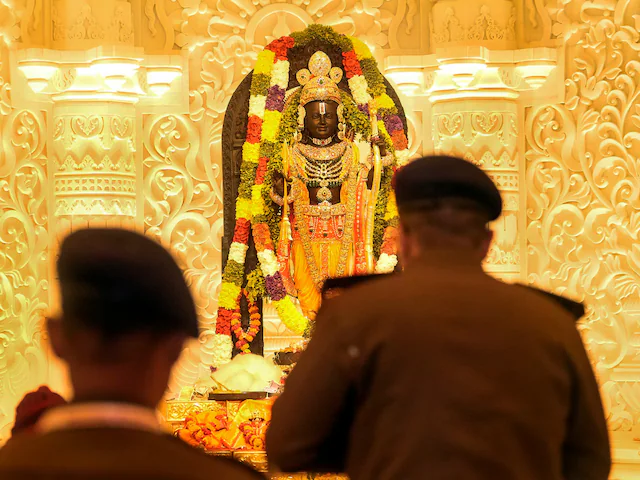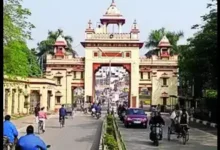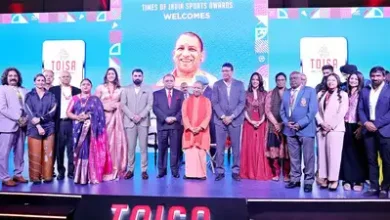Science Has Made It Possible for Surya Tilak of the Deity in Ayodhya to Celebrate Ram Lalla’s First Ram Navami
There’s going to be something remarkable happening on this Ram Navami. Ram Lalla, who was welcomed to the Ram Temple in Ayodhya in January, is going to see the sun kiss the forehead of the deity during Surya Tilak, also known as Surya Abhishek.

During the ceremony, Ram Lalla’s forehead will get direct sunlight. The Suryavanshis, often known as the descendants of the Sun, are said to have Lord Ram from the Ishvaku tribe.
QUOTE THE SCIENCE THAT UNDERSIDES IT?
Today at 12 pm, Ram Lalla, who is sitting in the sanctum sanctorum of Ram Mandir, will have his forehead illuminated by the sun’s beams for around 2.5 minutes. When Ram Lalla’s forehead is exposed to sunlight, a Surya Tilak is formed.
IIT-Roorkee scientists were brought in to develop the Surya Tilak mechanism. They used a device with premium mirrors and lenses to precisely focus the sun’s beams at an exact moment on Ram Lalla’s forehead.
According to reports, the device is a gearbox with lenses and mirrors set to reflect light. It will facilitate the reflection of sunlight at a certain moment into the sanctum sanctorum (garbhagriha) from the third level close to the “shikara.”
Because they are long-lasting and resistant to corrosion, brass and bronze were utilized to make components for the tilak device. According to a report by India Today, the gearbox has been designed to precisely place the sun on Ram Navami day every year based on the lunar calendar. For durability and minimal maintenance, the optical route, pipings, and tip-tilts are not spring-loaded.
Researchers have already tested the Surya Tilak method.
The lenses and brass tubes are made by the Bengaluru-based business Optica, while the Indian Institute of Astrophysics (IIA) provided technical assistance on the Sun’s course.
“100% the Surya Tilak will anoint the forehead of the idol of Ram Lalla,” according to CBRI scientist Dr. Pradeep Chauhan, who contributed to the design of the Ram temple, as reported by NDTV. “The gear-based Surya Tilak mechanism does not require electricity, batteries, or iron.”
The surya tilak device has also made use of Pancha Dhathu, a customary Indian alloy. According to India Today, former Isro scientist Manish Purohit said that three factors—archaeoastronomy, metonic cycle, and analemma—have been taken into account in order to guarantee that the Sun’s rays shine Ram Lalla’s forehead.
According to the scientist, archaeoastronomy is the process of designing monuments by using celestial locations. Analemma, on the other hand, is a figure-eight curve that shows how the tilt and orbit of Earth cause the Sun’s location to change every year. Finally, the Moon’s phases realign with the same days of the year for around 19 years during the Metonic cycle. According to Manish Purohit, this cycle was examined to make sure that the day of Ram Navami and the “tithi” it occurs on coincide.
HOW OTHER TEMPLES DO SURYA ABHISHEK
Sun temples belonging to the Hindu and Jain faiths perform Survya Abhishek.
Suriyanar Kovil Temple (Tamil Nadu): Dedicated to Surya, this 11th and 12th century temple is arranged such that, during certain times of the year, sunlight aligns with precise locations within the temple, lighting the god, Suriyanar (Sun), and his consorts, Ushadevi and Pratyusha Devi.
The Nanarayanaswamy Temple in Nagalapuram district of Andhra Pradesh is the site of a five-day Surya Puja Mahotsavam. Every day, the sun’s rays enter the temple and pass through several stages. Over the course of the five days, the Sun’s rays travel from the feet to the navel of the god in the garbhagriha, which is Lord Vishnu’s “Matsya avatar” (fish).
Mahalakshmi Temple (Maharashtra): The biannual Kiranotsav is a well-known festival held at the Chalukyan Mahalakshmi Temple in Kolhapur. When sunlight strikes the deity’s idol in the temple straight via the Garud Mandap to reach the “garbhagriha,” it is known as the uncommon Kiranotsav occurrence. Twice a year, the feet of the goddess Mahalaxmi get sunlight, and on two days, the idol’s center receives it as well. The deity is completely bathed in sunshine on two distinct days.
Koba Jain Temple (Gujarat): Every year, at the Koba Jain Temple in Ahmedabad, Surya Abhishek is held when sunlight strikes the marble statue of the god Mahaveerswami directly on its forehead for three minutes at 2:07 pm. Thousands of Jains from all across the world attend the yearly ceremony in Koba.
Unav Balaji Surya Temple (Madhya Pradesh): The temple honors its patron, the Sun God, with a festival held in Datia. The idol located in the temple’s sanctum sanctorum receives direct sunlight at sunrise.
Modhera Sun Temple (Gujarat): This 11th-century temple has a similar unusual occurrence twice a year when sunlight enters the building and falls on the statue of the Sun God.
Konark Sun Temple (Odisha): This Sun God-focused temple dates back to the 13th century and is renowned for the way sunshine fills it, especially before dawn. The layout of the temple makes sure that sunlight reaches the main entrance, passes through the several portals, and illuminates the “garbhagriha” that is located within.
Ranakpur Jain Temples (Rajasthan): Built in the 15th century amid the Aravallis, the temple’s white marble interior is arranged to allow sunshine to reach its inner sanctuary. Additionally, the design of the building permits sunlight to fall straight on the idol of the Sun God.
Gavi Gangadhareshwara Temple (Karnataka): Lord Shiva is worshipped in the Gavipuram Cave Temple, which is located close to Bengaluru. Every Makar Sankranti, the sun shines on the Nandi statue first, then covers the whole deity, ending at the foot of the Shivlingam. The garbhagriba, carved out of a certain kind of rock, allows sunlight to shine through its normally gloomy cave interior.







